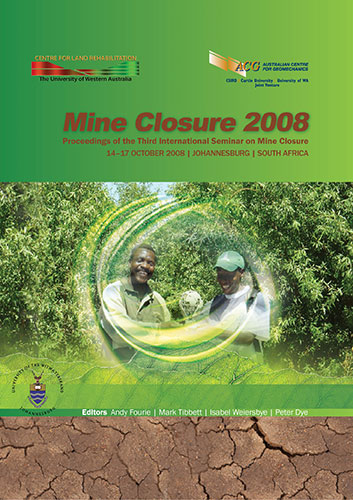Stabilization of Pyritic Solid Phases to Mitigate Acid Generation Potential and Metals Leaching

|
Authors: Gillow, J; Horst, J Paper is not available for download Contact Us |
DOI https://doi.org/10.36487/ACG_repo/852_48
Cite As:
Gillow, J & Horst, J 2008, 'Stabilization of Pyritic Solid Phases to Mitigate Acid Generation Potential and Metals Leaching', in AB Fourie, M Tibbett, I Weiersbye & P Dye (eds), Mine Closure 2008: Proceedings of the Third International Seminar on Mine Closure, Australian Centre for Geomechanics, Perth, pp. 531-538, https://doi.org/10.36487/ACG_repo/852_48
Abstract:
This paper will review the concept of halting and/or controlling the oxidation of pyritic solids through successful bench testing of a process developed to geochemically-stabilize lead and arsenic-bearing pyritic solids. The solids tested have been contributing to low pH and elevated arsenic concentrations in the groundwater underlying a site in the eastern U.S. The goal of the stabilization was to provide sufficient long- term control to allow the materials to be safely consolidated in a vadose-zone environment, while still protecting groundwater and the environment. A conceptual geochemical model was developed based on an in-depth analysis of the source material mineralogy and natural sequestration mechanisms affecting the arsenic and lead. This model provided the basis for selecting the appropriate stabilization chemistry. The solids that were the focus of the study were primarily comprised of iron oxide minerals (up to 33% iron), with pyritic sulphur in excess of 1% by weight in some areas. The solids had a corresponding net acid generation potential of over 40 tons of calcium carbonate per 1000 tons of material (tons/k). In addition to the trace amounts of lead and arsenic in the pyrite, solid anglesite presented a second source of lead through the intrinsic solubility of that mineral phase. The natural oxidation of the sulphide minerals was releasing acidity, iron, arsenic, and lead, with the acidity increasing the mobility of the metals. The iron oxides also provided surfaces to which the arsenic and lead could partition, but still be available to desorb into water percolating through the material. The primary components of the stabilization chemistry were designed to address the net acid generation potential, the leachable lead and arsenic separately. When combined with the materials, the amendments worked in synergy to enhance pH buffering and decrease metal leachability. In the testing, homogenates parameters requiring treatment ranged up to >15 tons/k of acid generation potential, 24,000 milligrams per kilogram (mg/kg) of total lead, and 600 mg/kg of total arsenic. The initial phase of testing involved a single homogenate, which was then followed by additional testing of the most promising amendment admixture. This last step applied the selected amendment admixture to multiple additional samples of the original treatment homogenate, as well as to several new homogenates representing a range of total inorganic contaminant and mineral characteristics that might be encountered in the material. Testing of multiple batches showed that the amendments were capable of successfully moderating pH to neutral/slightly alkaline conditions, dropping arsenic leachate concentrations from as much as 0.3 mg/L to <0.02 mg/L, and dropping lead leachate concentrations from as much as 34 mg/L to 0.2 mg/L in the most highly-impacted material. The long-term stability of the treated material is also discussed in this paper.
References:
EPA (1996) Method 3052, microwave assisted acid digestion of siliceous and organically based matrices in Test
Methods for Evaluating Solid Wastes: Physical/Chemical Methods. EPA SW-846, U.S. Environmental
Protection Agency, Office of Solid Waste and Emergency Response, Washington, D.C. Available at:
Jackson, M.L., Lim, C.H. and Zelazny, L.W. (1986) Oxides, Hydroxides and Aluminosilicates in Methods of Soil
Analysis, Part 1, Physical and Mineralogical Methods, A Klute (ed.). Agronomy Monograph No. 9. Soil Science
Society of America, Madison, Wisconsin.
Keon, N.E., Swartz, C.H., Brabander, D.J., Harvey, C. and Hemond, H.F. (2001) Validation of an arsenic sequential
extraction method for evaluating mobility in sediments. Environmental Science and Technology, 35,
pp. 2778-2784.
Tessier, A., Campbell, P.G.C., and Bisson, M. (1979) Sequential extraction procedure for the speciation of particulate
trace metals. Analytical Chemistry, 51, pp. 844-851.
Wright, M.T., Parker, D.R. and Amrhein, C. (2003) Critical evaluation of the ability of sequential extraction procedures
to quantify discrete forms of selenium in sediments and soils. Environmental Science and Technology, 37,
pp. 4709-4716.
© Copyright 2025, Australian Centre for Geomechanics (ACG), The University of Western Australia. All rights reserved.
View copyright/legal information
Please direct any queries or error reports to repository-acg@uwa.edu.au
View copyright/legal information
Please direct any queries or error reports to repository-acg@uwa.edu.au